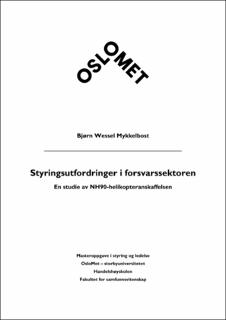| dc.description.abstract | The purpose of the study has been to focus on governance challenges in the defense sector. In a security situation where both Norway and its allies recognize the importance of a strengthened defense, mistakes made in the past cannot be repeated. This study may contribute in a small way to increased insight into the topic.
The NH90 procurement was chosen as a case study, as the material acquisition can represent a unique case that can illuminate the issues. Defense material acquisitions involve complex collaborations and many stakeholders. Failure to achieve goals in material acquisitions can result in, among other things, a lack of military capability and wastage of public funds.
The theoretical framework used in the study is Ansell & Gash's characteristics of institutional design and the collaborative process. The data used in the study consists of selected public documents, with document studies chosen as the analytical method. The study has highlighted various aspects of collaboration in the helicopter procurement that can provide insights into challenges in collaboration within public organizations.
In examining the institutional design, it was highlighted that many actors were involved. The defense sector has undergone organizational changes that may have influenced the significance of roles. The study indicates that over time, there may have been an increased degree of formalization of governance structures and efforts to remove communication barriers. However, it cannot be conclusively determined whether this has affected the NH90 procurement. Several examples of the need for consensus orientation have been presented. Characteristics of deadline use have been addressed and discussed.
Several challenges in the collaboration process have been discussed. Communication, trust-building, the degree of commitment to the collaboration process, and a shared understanding of the problem are variables highlighted in the discussion. It was also discussed whether it was possible to find motivation through small wins along the way. Significant delays and lack of results may have left little reason to celebrate. | en_US |
